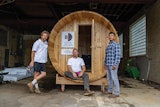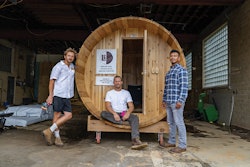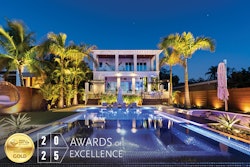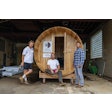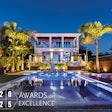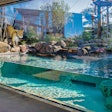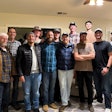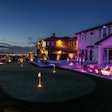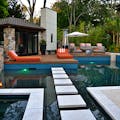
One of the reinvented company's specialties has been vanishing edges, and though they've only been at it a short time, Dave and Dunn have learned a great deal about the materials, methods and the mechanics that go into a well-designed and executed project.
Materials Matter
Getting the edge of a negative- or infinity-edge pool straight and true is the top priority for any contractor hired to build one. It's a difficult job, but one that's made easier if you pick the right materials, according to Dunn.
"When the guys lay the stone work, we try to use material that you can grind at a later date. So on our negative edges, we'll use a granite or a limestone," he says.
"We try to make them as perfectly as we can, but you're always going to have a little bit of variance, maybe 116 of an inch. So you can go back and buff that out, and it'll be invisible to the naked eye. We try to do the same thing with our materials on the infinity edge, using a quartzite or a stone that you can grind on to get that perfect flow that you want."
other direction.>"There's a wind that comes from below the pool, up from the golf course and up this valley that blows toward the back of the house," Dunn explains. "Anyway, one day I walked to the back of the house to look at the landscape, and everything was just soaked. The wind just carried that water all the way from the back side of the weir up to the house and windows.
"We learned a couple of things with that one."
First lesson: If you cut a slot into the pool, the water level drops down a little after the pump shuts off. When it's running, you're still running the risk that the wind will pick up the water spilling over the edge and throw it, but when the system is shut down, the water drops down about an inch, doesn't hit the edge, and stays in the pool. This dropped level isn't noticeable to the casual observer, Dunn says, and the edge effect remains intact.
"Or, we've done designs where we put a pump in so we can actually push that extra water into a surge tank to keep that from happening."
Serenity
Another big-budget project, this one for a homeowner named Ware, encompassed a dozen separate bodies of water, providing a career's worth of learning opportunities in a single job.
In this case, the homeowner purchased a house, razed it, then called on designers and architects, home builders, and Dunn to bring his vision of a luxurious home surrounded by artfully integrated bodies of water to life.
Dunn's favorite part of the complex, multi-staged job is the reflecting pond situated in front of the guest house. A long, skinny and shallow pool, it's made for contemplation rather than recreation.
"They were going for an ultra-contemporary feeling, and they wanted to have water everywhere," he says. "This isn't made for 14 grandkids to run and jump and play in, because the water would get displaced. It's more of a piece of art than a pool."
Unlike a lot of modern art, though, this piece required extreme care and precision to create the impression that the water isn't bound by borders but rather eases itself naturally into a neat square on the surrounding deck.
"The biggest thing with those is your elevation has got to be perfect," Dunn explains. "You've got to keep that flooring (on the deck) coming away from the house, and you also want to drain rainwater away from it."
Another part of the Ware property features a pool with a similar edge treatment of sealed limestone (which can be finely ground for uniformity) on three sides, and an infinity edge clad in tile on the fourth.
Because this pool - the biggest on the property - is meant for swimming, Dunn again had to be mindful of where water would end up.
Much of that displaced water flows over the wet edge of the blue porcelain tile, while water slips into cracks created between the deck and the vessel on the other three sides, where it's collected and recirculated.
High Expectations
Dunn Designer Pools does about 15 pools per year, about a third of them in the upper price range and the rest averaging around $50,000, projects Dunn takes on and "knocks out" to keep crews busy. For the former clients, however, there's a good deal of planning and design involved. This is normally done before Dunn is hired, and often by the homeowner himself.
"Our customers tend to be pretty involved, and for a lot of them it's not their first rodeo," he says. "They've had different pools in different homes so they can add their input as far as what they want.
"They might need some guidance on how to get there, though. But a lot of them either have designers, or they're architects themselves. We do some smaller design stuff, but this bigger stuff is designed on the overall plan and given to us: 'Here. You make it work.'"
For Dunn, the crucial part of making these projects work is to make sure the water that appears to spill out of the pool and onto the golf course doesn't actually do that.
"On an infinity pool, you're going to want another pump in there in case the trough fills up too much," he explains. "We'll have a leveler in there with two metal prongs that stick down on the side of the trough. When the water contacts the prongs, it completes a circuit with the pump and turns it back on.
"That way the pump will go on until you have time to fix the valve and the water won't overflow that trough and run down to the golf course or over expensive landscaping.
"You want to have a backup for your backup."
Finishing Touches
Dunn focuses on the finer points of building vanishing-edge pools, and says he's careful that every element - each edge, every slot - is polished to perfection before he moves on to another.
Sometimes, though, the finishing touches prove not to be final.
"Well, on the Ware pool we kind of messed ourselves up because when we put in the circ pumps," Dunn says, "we also put overflow pumps on to push a little bit more water and make the pools look perfectly full.
"But the homeowner didn't want any type of noise at all, so we ended up taking those out and just leaving the circ pumps on so that the pools stayed full but barely trickled over.
"So without that overflow pump, it's a quieter edge, but it also needs to be that much more precise," Dunn says. "The less water you're moving the more perfect the edge needs to be."
Had the company relied on a heavy bead of water pushed by booster pumps to obscure imperfect edges, they'd have been in a real bind.
To put it another way, "good enough" wouldn't have been good enough.
Comments or thoughts on this article? Please e-mail [email protected].




















